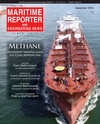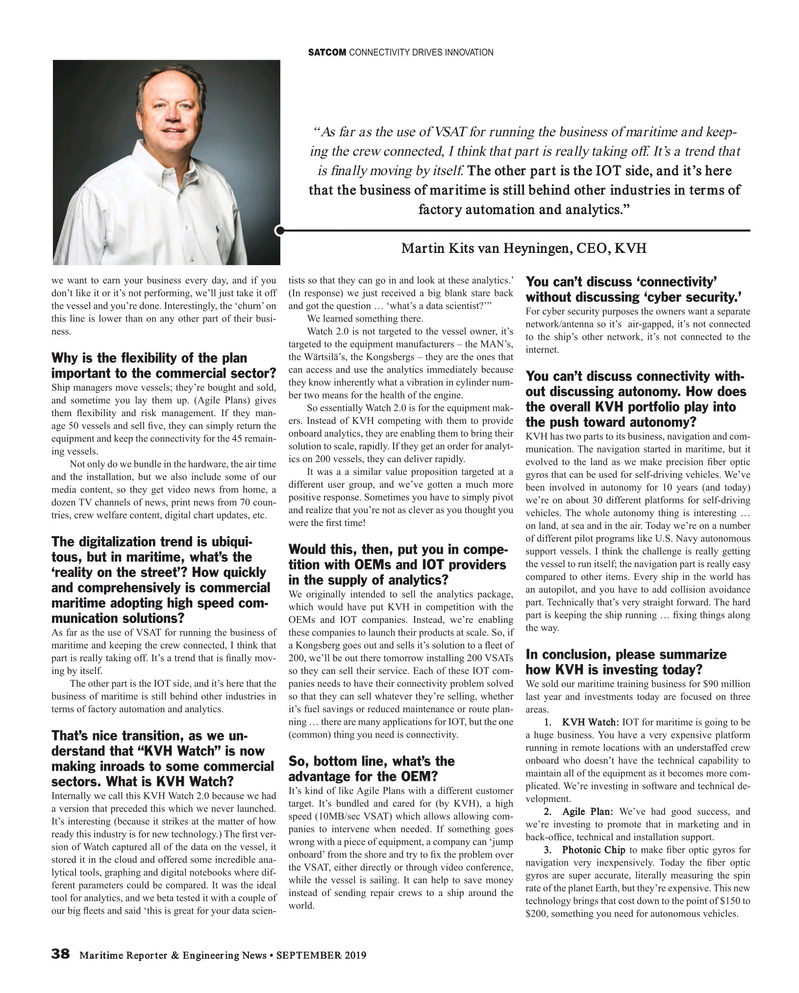
Page 38: of Maritime Reporter Magazine (September 2019)
Satellite Communications
Read this page in Pdf, Flash or Html5 edition of September 2019 Maritime Reporter Magazine
SATCOM CONNECTIVITY DRIVES INNOVATION “As far as the use of VSAT for running the business of maritime and keep- ing the crew connected, I think that part is really taking off. It’s a trend that is ? nally moving by itself. The other part is the IOT side, and it’s here that the business of maritime is still behind other industries in terms of factory automation and analytics.”
Martin Kits van Heyningen, CEO, KVH we want to earn your business every day, and if you tists so that they can go in and look at these analytics.’
You can’t discuss ‘connectivity’ don’t like it or it’s not performing, we’ll just take it off (In response) we just received a big blank stare back without discussing ‘cyber security.’ the vessel and you’re done. Interestingly, the ‘churn’ on and got the question … ‘what’s a data scientist?’”
For cyber security purposes the owners want a separate this line is lower than on any other part of their busi- We learned something there. network/antenna so it’s air-gapped, it’s not connected ness. Watch 2.0 is not targeted to the vessel owner, it’s to the ship’s other network, it’s not connected to the targeted to the equipment manufacturers – the MAN’s, internet.
the Wärtsilä’s, the Kongsbergs – they are the ones that
Why is the ? exibility of the plan can access and use the analytics immediately because important to the commercial sector?
You can’t discuss connectivity with- they know inherently what a vibration in cylinder num-
Ship managers move vessels; they’re bought and sold, out discussing autonomy. How does and sometime you lay them up. (Agile Plans) gives ber two means for the health of the engine.
So essentially Watch 2.0 is for the equipment mak- the overall KVH portfolio play into them ? exibility and risk management. If they man- ers. Instead of KVH competing with them to provide the push toward autonomy?
age 50 vessels and sell ? ve, they can simply return the onboard analytics, they are enabling them to bring their
KVH has two parts to its business, navigation and com- equipment and keep the connectivity for the 45 remain- solution to scale, rapidly. If they get an order for analyt- munication. The navigation started in maritime, but it ing vessels. ics on 200 vessels, they can deliver rapidly. evolved to the land as we make precision ? ber optic Not only do we bundle in the hardware, the air time and the installation, but we also include some of our It was a a similar value proposition targeted at a gyros that can be used for self-driving vehicles. We’ve media content, so they get video news from home, a different user group, and we’ve gotten a much more been involved in autonomy for 10 years (and today) positive response. Sometimes you have to simply pivot we’re on about 30 different platforms for self-driving dozen TV channels of news, print news from 70 coun- and realize that you’re not as clever as you thought you vehicles. The whole autonomy thing is interesting … tries, crew welfare content, digital chart updates, etc.
were the ? rst time! on land, at sea and in the air. Today we’re on a number of different pilot programs like U.S. Navy autonomous
The digitalization trend is ubiqui-
Would this, then, put you in compe- support vessels. I think the challenge is really getting tous, but in maritime, what’s the the vessel to run itself; the navigation part is really easy tition with OEMs and IOT providers ‘reality on the street’? How quickly compared to other items. Every ship in the world has in the supply of analytics?
and comprehensively is commercial
We originally intended to sell the analytics package, an autopilot, and you have to add collision avoidance maritime adopting high speed com- which would have put KVH in competition with the part. Technically that’s very straight forward. The hard munication solutions?
OEMs and IOT companies. Instead, we’re enabling part is keeping the ship running … ? xing things along the way.
As far as the use of VSAT for running the business of these companies to launch their products at scale. So, if maritime and keeping the crew connected, I think that a Kongsberg goes out and sells it’s solution to a ? eet of
In conclusion, please summarize part is really taking off. It’s a trend that is ? nally mov- 200, we’ll be out there tomorrow installing 200 VSATs ing by itself. so they can sell their service. Each of these IOT com- how KVH is investing today?
The other part is the IOT side, and it’s here that the panies needs to have their connectivity problem solved We sold our maritime training business for $90 million business of maritime is still behind other industries in so that they can sell whatever they’re selling, whether last year and investments today are focused on three terms of factory automation and analytics. it’s fuel savings or reduced maintenance or route plan- areas.
ning … there are many applications for IOT, but the one 1. KVH Watch: IOT for maritime is going to be (common) thing you need is connectivity. a huge business. You have a very expensive platform
That’s nice transition, as we un- running in remote locations with an understaffed crew derstand that “KVH Watch” is now onboard who doesn’t have the technical capability to making inroads to some commercial So, bottom line, what’s the maintain all of the equipment as it becomes more com- advantage for the OEM?
sectors. What is KVH Watch?
It’s kind of like Agile Plans with a different customer plicated. We’re investing in software and technical de-
Internally we call this KVH Watch 2.0 because we had target. It’s bundled and cared for (by KVH), a high velopment.
a version that preceded this which we never launched. 2. Agile Plan: We’ve had good success, and speed (10MB/sec VSAT) which allows allowing com-
It’s interesting (because it strikes at the matter of how panies to intervene when needed. If something goes we’re investing to promote that in marketing and in ready this industry is for new technology.) The ? rst ver- back-of? ce, technical and installation support.
wrong with a piece of equipment, a company can ‘jump sion of Watch captured all of the data on the vessel, it 3. Photonic Chip to make ? ber optic gyros for onboard’ from the shore and try to ? x the problem over stored it in the cloud and offered some incredible ana- navigation very inexpensively. Today the ? ber optic the VSAT, either directly or through video conference, lytical tools, graphing and digital notebooks where dif- while the vessel is sailing. It can help to save money gyros are super accurate, literally measuring the spin ferent parameters could be compared. It was the ideal instead of sending repair crews to a ship around the rate of the planet Earth, but they’re expensive. This new tool for analytics, and we beta tested it with a couple of technology brings that cost down to the point of $150 to world.
our big ? eets and said ‘this is great for your data scien- $200, something you need for autonomous vehicles.
38 Maritime Reporter & Engineering News • SEPTEMBER 2019
MR #9 (34-41).indd 38 MR #9 (34-41).indd 38 9/12/2019 11:23:53 AM9/12/2019 11:23:53 AM

 37
37

 39
39
